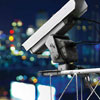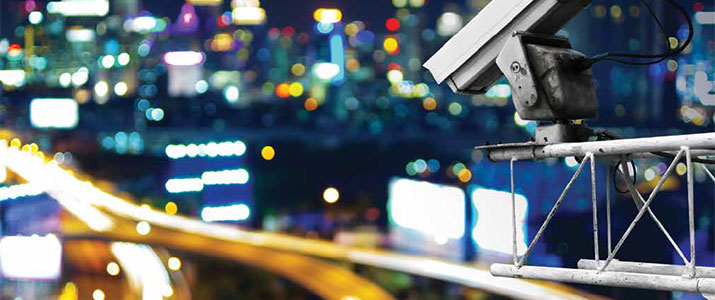
Page 2 of 3
Distance – The Other Variable
 Zoom cameras allow targets from hundreds of feet away to be viewed
up close, while megapixel cameras can cover larger areas with fewer
cameras. But is it really that simple?
Zoom cameras allow targets from hundreds of feet away to be viewed
up close, while megapixel cameras can cover larger areas with fewer
cameras. But is it really that simple?
Savvy integrators and end users know to make decisions based
on what they have actually used in the real world, not on product
claims. Surveillance professionals are also familiar with camera terminology, such
as pixels-per-foot (PPF), which can help evaluate the utility of video equipment to
perform an expected task.
For example, a systems integrator might decide how many pixels he or she
would need to recognize a person or to read a license plate. Considering that number
of pixels, how it relates to surveillance camera resolutions and the size of an
area being covered can point to which equipment might provide the needed pixel
count, or resolution, to perform at the required level.
However, an often overlooked aspect when specifying cameras to cover large
areas is the distance of the target from the camera. This variable especially relates
to light collection, specifically how much light is collected by the image sensor,
based on the distance of the target from the camera. The inverse-square law explains
how light decreases over distance as the amount of light that reaches an
image sensor is “inversely proportional to the square of the distance” between the
light source and the camera. For example, if the distance is doubled, illumination
is reduced by a factor of four.
Much more light is collected if the camera is located close to the target, but if
the target is far from the camera, fewer photons of light are sensed. Offsetting the
effects of this one simple variable can make the difference between a surveillance
system that does the job and one that fails. Technology choices can mitigate the
challenges, but at what cost?
The solution may be as simple as locating the camera
closer to the target.
Let’s take a look at how the distance of a target
from a surveillance camera can negatively impact
camera functionality related to light collection.
Distance and Light Sensitivity
Using a standard resolution, video surveillance camera,
an operator could read a license plate with a 8MM
focal length lens from about 30 feet away (based on
the guideline of 50 horizontal pixels-per-foot).
An alternative option is placing a megapixel camera
at a distance of 90 feet, for example, where data
and power sources are readily available. Using a typical,
two megapixel camera at a distance of 90 feet,
with the same pixels-per-foot, a 14MM focal length
would be needed. At this focal length, and based on
typical sensor sizes (for example, 1/2.7”), the light
available per pixel at the sensor is reduced by approximately
a factor of nine.
Considering the element of light, the lens diameter
has to scale along with the distance ratio in order to
increase the collection area for light. So, at 300 feet, a
lens about 10 times larger would be required, and the
lens would need 100 times more light-gathering power
to allow the same low-light level sensitivity. There also
must be sufficient light to view the required subject,
and the smaller pixel sizes make them less sensitive
to light, which can further complicate the issue. Unfortunately,
these diameters and capabilities are not
available with today’s standard lenses.
Variables impacting the effectiveness of surveillance
cameras viewing long distances include maximum aperture
opening, lens diameter and focal length. These
variables make it critical to test the functionality of any
camera system before committing to a large installation
and making a significant investment.
Capturing useful video images from far away requires
additional investment in multiple elements of
a surveillance camera system, especially more expensive
lenses to provide larger pixel sizes. The ability
to see greater detail using a higher-resolution camera
does not address the physical requirements of sufficient
light to accomplish the task. Light levels diminish
across long distances, which can make viewing
distant locations, such as along a facility’s perimeter
or large outdoor areas, from a camera located hundreds
of feet away either impractical or prohibitively
expensive.
Challenges of Locating a Camera
The simplest solution to meet the challenge of capturing
video across long distances is to shorten the
distance. Instead of requiring cameras to view long
distances, why not locate the camera closer to the item
being viewed?
Here are some challenges with this solution:
- Limitations of IP network reach. IP cameras must
connect to the network, but the farthest reaches
of an enterprise might be beyond the network’s
reach. Locating cameras only within reach of the
network presents challenges of viewing distant
objects, especially related to decreases in light that
reaches the camera as the distance increases.
- No available power. Likewise, a distant perimeter,
parking lot or other asset might be located far
from any available power source.
- Is trenching practical? Digging trenches for electricity
and/or network connectivity is expensive,
and it may not be practical based on the environment.
For example, what if a protected asset is located
on the other side of a lake? What if it’s across
a public street? While erecting poles and stringing
wires is possible, this approach could disrupt aesthetics,
cause environmental concerns, create easy
targets for vandalism or be vulnerable to certain
weather conditions, such as violent winds.
Combining Solar Power
and Wireless Transmission
It is possible to overcome the challenges of locating
video cameras to view distant assets by using solar
power to operate the camera along with wireless transmission
to move the video signal from the camera to a network video management system.
This simple approach overcomes the
aforementioned technology challenges
and the potential higher expense of
generating clear images using cameras
to view across long distances, especially
the problem of not enough light. Shorter
distance means more light reaches
the camera, allowing even standardresolution
devices to capture images
clearly without specialized lenses, optics
or other additional technology expense.
Wireless access to video is changing
how security systems operate at the edge
of a network. Installing a surveillance
camera no longer requires a video cable
and a dedicated power source, and there
is no need to run wires through trenches.
New wireless systems can transmit video
through the air from remotely-located
cameras, up to a half a mile away, to a
centralized video hub that is connected
to the network and tied into a video
management system. The camera remains
close to the object being viewed,
vastly simplifying image capture and retention,
and potentially allows it to perform
at a much lower cost.
Solar panels, with five-day battery
storage, can provide power to special,
low-power, surveillance cameras used
to view remote locations. Such an approach
greatly expands the coverage
area of a video system at an affordable
price. Inexpensive, remote IP video surveillance
is crucial to securing perimeters
and large outdoor areas.
Self-contained camera systems,
those powered by solar energy that use
low-power, wireless, video transmission
in the unlicensed spectrum, are highly
mobile, which provides a dynamic and
adaptive approach to video surveillance
coverage. In the case of a special event
that requires additional security and
video coverage, cameras can be added
on an ad hoc basis, with no need to run
wires or pay other infrastructure costs.
For example, if there is a particular
problem area on a perimeter, the wireless
surveillance camera can be moved
to provide coverage of that area on
a temporary basis, and then moved
somewhere else, if another need arises.
A Simpler, Less-expensive
Approach
To design an effective surveillance system,
video cameras must be placed appropriately,
and a multitude of factors
have to be considered such as backlighting,
low-light levels and sufficient
image clarity.
The proliferation of higher-powered
zoom lenses and super-high-resolution
megapixel cameras in the market suggests
a wealth of new possibilities related
to camera placement. These systems
promise to see more with fewer cameras
and to enable end users to save money
in the process. However, every technology
has its limitations, and even the
best, most up-to-date camera systems
are only as good as the quality of the
image that reaches the camera, which is
a function of how much light reaches
the image sensor.
As the distance between the camera
and image sensor increases, the amount
of light that reaches the sensor goes
down. Even the highest-resolution camera
cannot see an image clearly unless
there is enough light. Too often, system
designers overlook the effect of distance
on how much light reaches the camera
or they design expensive systems to
overcome the problem. A simpler approach
is to put the camera nearer to
the object being viewed. New solarpowered,
wireless, video cameras can
do just that, resulting in less expensive
systems with superior
performance.
This article originally appeared in the August 2013 issue of Security Today.